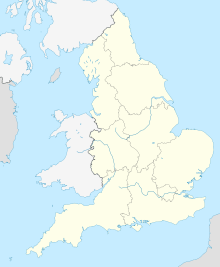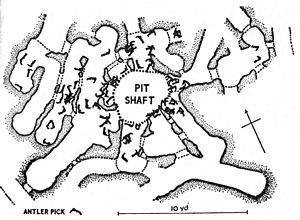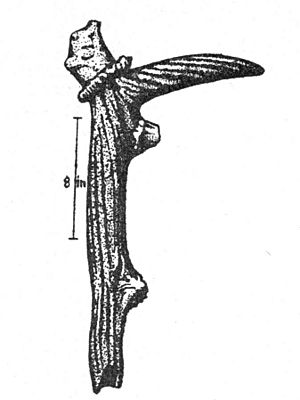Grime's Graves facts for kids

Interior view of the public pit at Grime's Graves
|
|
| Location | |
|---|---|
| Location | Weeting, Norfolk, England |
| Coordinates | 52°28′33″N 0°40′31″E / 52.47585°N 0.67541°E |
| Production | |
| Products | Flint tools |
| History | |
| Opened | c. 2600 BC |
| Closed | c. 2300 BC |
| Owner | |
| Company | Managed by English Heritage |
Grime's Graves is an amazing ancient site in Norfolk, England. It's a huge complex of Neolithic (New Stone Age) flint mining pits. People dug here about 4,500 years ago, from around 2600 BC to 2300 BC. They were looking for high-quality flint to make strong tools like axes.
This important site is located about 8 kilometers northeast of Brandon, Suffolk. Even after metal tools became common, flint was still used for building and for muskets. The site was first fully explored by an archaeologist named William Greenwell in the 1800s.
Contents
Digging for Flint
Grime's Graves covers a large area, about 37 hectares. It has at least 433 shafts, which are deep holes dug into the natural chalk. These shafts were made to reach layers of flint underground. The biggest shafts are over 14 meters deep and 12 meters wide at the top.
Imagine the work involved! It's thought that miners had to remove more than 2,000 tonnes of chalk from the larger shafts. This would have taken about 20 people around five months to do. They dug through an upper layer of flint (called 'topstone') and a middle layer ('wallstone'). But they were most interested in the deepest layer, the 'floorstone'.
Today, English Heritage manages the site. You can even visit Grime's Graves and go down into one of the old mine shafts.
How Ancient Miners Dug
To dig so deep, the ancient miners built wooden platforms and ladders. As they dug downwards, they piled the removed chalk and dirt around the shaft opening. They used turf to hold these piles in place. After they finished with a shaft, they carefully filled it back in.
This process left the landscape around Grime's Graves looking lumpy and pockmarked. This unique look probably inspired the later Anglo-Saxons to name the site after their god, Grim. The name "Grime's Graves" literally means "the masked one's quarries." People knew it was an old site, but its true purpose was only discovered in modern times. This happened when Canon William Greenwell excavated one of the shafts in 1868.
Similar ancient flint mines have been found in other parts of Europe. These include Cissbury Ring in England, Krzemionki in Poland, and Spiennes in Belgium.
Tools for Mining
The miners at Grime's Graves used special tools. Their main tools were picks made from the antlers of red deer. They likely also used wooden shovels, but these haven't survived as well.
Studies of the antlers show that most miners were right-handed. They preferred to use the left antlers that deer naturally shed each season. Archaeologists have found many antler picks. For example, 28 pits that were dug up to 2008 had an average of 142.5 antler picks each.
Once they reached the 'floorstone' flint, the miners dug tunnels sideways from the bottom of the shaft. These tunnels followed the flint layer. A medium-sized shaft could produce as much as 60 tons of flint nodules. These flint pieces were brought to the surface and roughly shaped on site.
These rough tools were then likely traded to other places for their final polishing. It's estimated that 60 tons of flint could make as many as 10,000 polished stone axes. These axes were the main product of the mines. Experts believe that Grime's Graves may have produced about 16,000 to 18,000 tonnes of flint in total.
Ancient Beliefs
One shaft (pit 15) at Grime's Graves seems to have been used for something special. It wasn't used for mining flint. Instead, it appears to have been turned into a shrine. Inside, archaeologists found an altar made of flint lumps. There was also a chalk bowl at its base, with antler picks piled around it. This suggests the miners had some kind of customs or beliefs connected to their work.
Supporting the Mines
Running such a large mining operation would have needed a lot of support. For example, if two shafts were open at the same time, they might have needed about 120 red deer. These deer would provide a steady supply of antlers for tools. They also provided skins, food, and other things the miners needed.
It's also possible that local farmers worked the mines part-time. This happened at many early metal mines during the Bronze Age and Iron Age. Grime's Graves was also close to the very rich soils of the Fens. Clearing forests in this area would have relied on local flint tools.
Later, during the Bronze Age, there was a lot of farming settlement here. Animal bones found in old mine shafts show that people kept cattle for milk, sheep, and some pigs. They also grew crops like barley, wheat, and peas.
Modern Discoveries
As mentioned, William Greenwell was the first to explore Grime's Graves in detail in 1868. Before his work, people didn't know what the holes in the ground were for. One priest in the 1700s thought they were left by Vikings. A century later, an amateur archaeologist thought they were the remains of a Celtic fortress. Greenwell's excavations finally revealed their true purpose as ancient flint mines.
Visiting Grime's Graves Today
Grime's Graves is now looked after by English Heritage. It is open to the public, and it's a unique experience. You can go down a 9-meter ladder and explore one of the ancient mine shafts. This is the only shaft of its kind open to the public in Britain. There is also a small exhibition area to learn more about the site.
Images for kids












